Looking for the perfect one week itinerary for Bali?
A plan that allows you to immerse yourself in the spirituality of the island, see as much as you can, adventure across islands, and simply enjoy the moment?
Do I have a treat for you!
Welcome, you’re in the right place. Skip down to the day-by-day itinerary, or grab a glass of wine and read through the whole Bali guide to prepare for the adventure of a lifetime!
Want to have this handy en-route to Bali? Pin it:
Bali, the Indonesian Island known as the Island of Gods, has made a name for itself as a destination in paradise.
Yet, in truth, it’s much more than that:
Bali, as well as its sister islands, Lombok, Lembongan, Penida, and the Gili Islands, is filled with jungle, Hindu temples, a variety of local and Western-friendly food, and a deep-seated spiritual energy that’s palpable, yet not exactly explicable.
It’s where I’ve had the most profound encounters, deepest meditations, and yet-to-be-told awakenings.
Bali has become a melting pot of cultures from around the world. This is thanks to digital nomads and expats who make Bali their new home, as well as summer tourists and backpackers who wish to explore the island.
I’ve spent a cumulate 6 or so months in Bali, spread across 2 years. During this time, I’ve explored the island itself as well as neighboring islands.
It’s safe to say, Bali has you in for a diverse adventure.
This one week itinerary for Bali is one I’ve recommended to friends and family who are new to Bali. I know it’s well-balanced between the hustle and bustle of some cities and the more serene areas of Bali.
This makes for a unique and memorable experience.
In a hurry? Here are the spark notes:
7 Day Itinerary Overview:
Ubud (Monkey Forest, Saraswati Temple, Mount Batur, Alchemy Yoga Center) + Ulun Danu Beratan Temple + Lembongan (Mangrove, Ceningan) + Canggu (Uluwatu Temple, Tanah Lot)
Protect yourself: SafetyWing
Book your tours: GetYourGuide.com
Book your hotels: Booking.com
Best ATM: Mandiri (blue)
Quick facts about Bali
Must-Stops and Must-dos in Bali
As you plan your trip to Bali, be sure to tick off these checkboxes:
- Monkey Forest and Saraswati Temple in Ubud
- Book a tour to see the sunrise atop Mount Batur and relax in the Hot Springs after breakfast
- Book a tour to Uluwatu Temple
- Enjoy the beaches at Canggu
- Book your driver for the airport transfer ahead of time (DM me on Instagram for my driver)
- Visit the Ulun Dan Beratan Temple
- Explore the mystical Tanah Lot Temple
Where to Stay in Bali – best accommodation types
Bali is packed with accommodations of all types. If you were to stay in Ubud longer as a digital nomad, you’d likely rent a private villa.
However, if you spend only one week in Bali, I recommend you stick to hotels and resorts for a higher budget and to homestays on a lower budget. Here are my top picks for each stop I recommend you include in your one week itinerary for Bali:
Ubud: Royal Ganesha Resort
Lembongan: Dream Beach Huts
Penida: Eden Nature Villas with Private Pool
Canggu: Theanna Villa and Spa
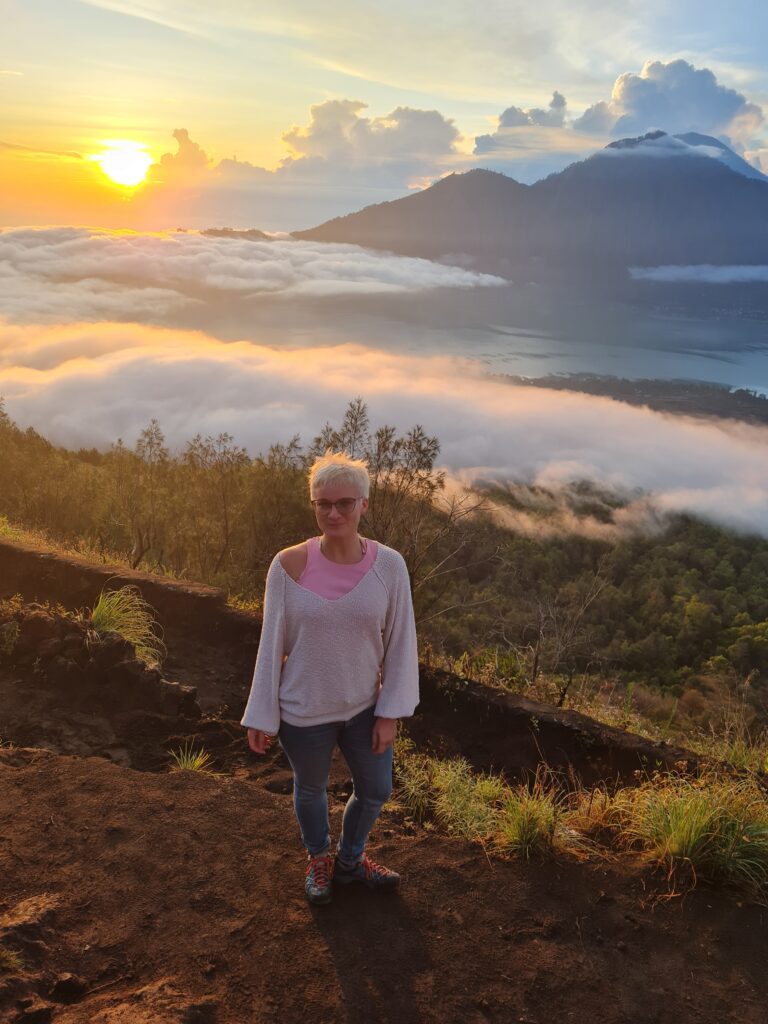
Best time of year to visit Bali
Bali and most of Indonesia have two distinct seasons: the dry (May-October) and the rainy season (November-April).
The rainy season typically lasts from November to April, however, you’ll begin to get regular downpours of rain starting in early October. During the rainy season, the humidity levels are at their highest and you’ll likely have two to three hours of rain every afternoon.
During the dry season, you can expect slightly lower levels of humidity and more tourists, though tourism is high throughout the year.
The best time to visit Bali is between May/June or October. During these months, it’s shoulder season. While tourists will be fewer due to work and school schedules, the weather will be fantastic and you’ll have the best chance at catching Mama Bali at her best.
What to Pack for your One Week Itinerary for Bali?
Bali is humid, the sun is relentless, and you’ll find yourself wanting to explore many Hindu temples.
As far as your packing list is concerned, you should pack a mix of cute outfits and clothes that cover your knees and shoulders. Don’t forget your bikini and sunscreen!
Here’s a quick checklist:
- Bikini and sunscreen
- Sunhat to prevent a heat stroke
- A thin pair of long pants or a sarong to cover up before entering temples
- A stola or thin jacket to cover your shoulders with
- Shorts and tops (it’s fine to walk around with your skin showing as long as you’re not inside a temple)
- A journal to capture all the emotions and feels
- An adapter if needed (Bali has EU-style two-hole plugs)
- Travel documents (6 months validity left in Passport)
- Visa (see below)
- Feminine products (especially tampons/menstruation cups as they’re hard to find and expensive to buy in Bali)
- Deodorant
- Flipflops and closed-toed shoes for hikes
- First Aid Kit (flu medicine, diarrhea meds + medicinal charcoal, band-aids)
- Disinfectant
- Mosquito repellant
How much money is enough for one week in Bali?
Your budget requirements for a one week itinerary for Bali will largely depend on your desired quality of life in Bali.
Generally speaking, you can do Bali very cheap on a backpackers’ budget, on a slightly higher 3 star hotel budget, and splurge on top-luxury hotels throughout the island.
A detailed analysis of budgeting for Bali can be found here – there’s something there for backpackers, solo travelers, digital nomad couples, and high-end luxury travelers.
Typically, your visa on arrival should cost approximately $35. Your flight, of course, depends on your city of origin. I’ve found that Qatar and Scoot tend to offer the best flight options, and I recommend checking booking.com for your best deals.
A Backpacker’s budget: If you’re ok with eating at local Warungs, staying at homestays, and taking group transportation throughout Bali and across to Nusa Lembongan or Penida, I’d say that $30 to $40* a day could be enough.
Mid-budget: On the other hand, if you’re looking to hire a private driver, stay at medium-priced hotels, and be sure you’re getting on the better boats to Penida, I’d recommend budgeting for around $80 to $100* a day, including hotels. That way, you’ll have budget for a $30 to $40 hotel per night, and can eat at any restaurant for up to $15 to $20.
Luxury Budget: Finally, if you’re curious about a luxury week in Bali, the sky is the limit. You can get private villas with private pools inside of 5* luxury resorts for upwards of $500* a night.
*This excludes visas, travel insurance, flights, and vaccinations.
You see, the budget range is massive in Bali which makes the island of gods accessible to just about anybody.
It’s a good idea to have a card without foreign transaction fees and without ATM fees as that will save you tons of money. Keep an eye out for the blue Mandiri ATMs as they have no withdrawal fees.
If you want more for your buck, you might be curious about going to Vietnam instead of Bali. Check for yourself.
What is the Best Travel Insurance for one week in Bali?
The Balinese driving etiquette is lax, to say the least, humidity contributes to lots of mold which can lead to skin diseases, and mosquitos sometimes carry diseases.
Ergo, absolutely do get travel insurance for your trip to Bali. For just one week, your domestic insurance might cover you, but do check for tropical diseases, and motorcycle and water sports coverage.
If your domestic insurance doesn’t fully cover you, I recommend SafetyWing for your trip. It’s robust, cheap, and adjustable to your needs. You can even book coverage on your layover en route to Bali if you’ve forgotten.
Their rates start at $45 per month if you’re on a nomadic or backpacker’s adventure. Alternatively, you can also book SafetyWing coverage for just one trip.
Is the WiFi fast in Bali? What is the Best SIM Card?
The WiFi in Bali has significantly improved over the years. While you might find a slow connection in the wilds of Bali – Northern Bali, in between cities – the Internet within the cities and all tourist hotspots is strong.
Hotels and homestays are equipped with fast WiFi, and so are most cafes and restaurants.
I recommend you get a local SIM card from Telkomsel upon arrival. They have the best coverage. If you have the time, wait to get a SIM card until you’re outside the airport as the rates are cheaper.
However, if you want to hit the ground running, there’s no harm in getting a SIM card right at the airport.
You’ll have that chance after you go through customs. Once you’ve passed through the ATM and currency conversion booths, you’ll see a red Telkomsel boot on the left-hand side.
Do I need a visa to go to Bali
Most nationals need to register for a Visa On Arrival before entering Bali. The visa costs $35 and lasts for 30 days.
While you could get in line to get it on arrival at the airport, it’s much faster to register for your VOA online via this website.
This should save you up to an hour at the airport.
Recently, Bali introduced a tourist tax on top of the visa. Based on what I’m reading, the tax is to be paid online before or upon arrival and there are police checks.
It costs $12 and is meant to support the maintenance of the island. I’d say just go and pay it, and keep a receipt handy in your phone in case you get stopped by the police.
Is Bali Safe?
As far as robberies and street crimes are concerned, you’ve got little to worry about in Bali. In that sense, Bali is safe.
The biggest safety concern in Bali is driving as the driving etiquette across the island is poor and you’re in constant danger of getting into an accident, even if it’s not your own fault.
While I love the flexibility of renting a scooter when there, it’s much safer to travel by car. If you do get a scooter, wear a well-fitted helmet and long pants and sleeves for extra protection.
The other health concern in Bali is hygiene and Bali Belly – 2 to 3 days of diarrhea. Pack appropriate medicine, disinfectant, and check the restaurant reviews for “Bali Belly” before dining there. If you do that, you’re on the safe side.
Tips to know before you go to Bali
- Beware of scams and pickpocketing. Check for going prices online or by walking around a few vendors before handing over your money. Keep a lock or hand on your sip-stored belongings.
- Protect your body: use sunscreen and stay hydrated. The sun in Bali is brutal, even behind clouds, and the humidity will quickly drain your body of its fluids. Keep a water bottle with you at all times and re-apply sunscreen regularly. Even if it’s sticky.
- Don’t drink the tap water: You will get Bali Belly. Don’t use it for oatmeal, ice cubes, spaghetti water, or even for brushing your teeth.
- Wear a HELMET on scooters: This is not the time to look cute. Wear that helmet.
- Use mosquito repellant and only book rooms with mosquito nets: Mosquitos in Bali tend to carry and transmit deceases that can get you bedridden for weeks. Try to protect yourself with nets and repellants at all times.
- Get travel insurance: With Bali being a tourist hub for travelers from around the world, prone to earthquakes, and having slightly poor driving etiquette on the road, travel insurance is not optional. I love SafetyWing but any that covers all activities and cancellations due to sickness will do.
- Respect the environment: Sadly, you will see tons of trash in streets, corners, and rivers in Bali. Please be mindful of not contributing to the waste by cleaning up after yourself at all times.
- Respect local customs and traditions: Bali is a predominantly Hindu island. Be mindful to not step on offerings laid down in front of homes, take your shoes off before entering a temple or home, and cover-up at spiritual sites.
- Negotiate on prices: Bartering is expected in Bali and built into the asked price. In other words, if you don’t negotiate, you’ll inevitably end up over-paying. Shopping, tours, drivers, taxis, it’s all negotiable.
The Perfect One Week Itinerary for Bali
Bali is dubbed the Island of Gods. If you follow this one week itinerary for Bali, you’ll find countless influences of Hinduism everywhere on the island.
If you’re on the spiritual side of life, you’ll likely feel quite a strong, grounding energy once you set foot on the island. Even if you are only there on a one week itinerary for Bali.
It’s a good idea to set your intentions for your 7 day trip to Bali ahead of time, and create ample pause and rest throughout your 7 day itinerary to take in the very special atmosphere of Bali.
If you do this, Bali can easily become one of the most peaceful destinations for travelers and nomads alike.
With that, let’s get into the one week itinerary for Bali I’d follow in a heartbeat.
Save this article for later:
Day 1: Arrive in Bali and go to Ubud (three nights)
Upon arriving at the only airport in Bali, Gusti Ngurah Rai International Airport, book a driver to head straight to Ubud. Email or DM me on Instagram for my driver’s number. He’s great!
Ubud is the spiritual center of the island and spending three nights there will help you acclimate to the island while exploring many nearby attractions.
Located in the Gianyar regency, in the center of the island, Ubud likely offers what most people think of when considering a week in Bali:
Lush green rice fields, spirituality, meditation, yoga, art, markets, and workshops to learn local traditions such the traditional dances or how to make Hindu offerings.
In Ubud, you’ll find iconic attractions such as the Pura Taman Saraswati Temple, the Ubud Palace, and the Monkey Forest.
Leisurely strolls lead across the Sayan Ridge as well as down the Campuhan Ridge Walk.
It’s why Ubud deserves a whole three nights on your 7-day itinerary for Bali.
If you arrive at night, check into your hotel, grab dinner, and get some rest ahead of a packed week in Bali.
However, if you still have some daylight left after checking in, you could go to Saraswati Temple (closes at 6 pm), the Monkey Forest (closes at 5 pm), or catch a yoga class at Alchemy Yoga (last class starts at 6 pm) to get the airplane stiffness out of your body.
Top Hotels in Ubud:
For as short a stay as this, I recommend one of two areas in Ubud.
Ubud Center will place you at the heart of the city and allow you to walk to many attractions.
Meanwhile, Payangan will provide you with a selection of serene, tranquil, and luxurious resorts that are just a 15 minute drive outside of the city center.
Check out my top choices of hotels that offer a private villa/pool experience in Ubud.
Budget Hotel: Metteya Healing House
Midrange Hotel: Kailash Suites Ubud
Luxury Hotel: Royal Ganesha Resort
Best Massage in Ubud: Hands-down, Synergy Spa is the best massage experience in town. I went there twice a week most weeks. Their service, ambience, and masseuses are top-notch, and the value they offer is unmatched in town.
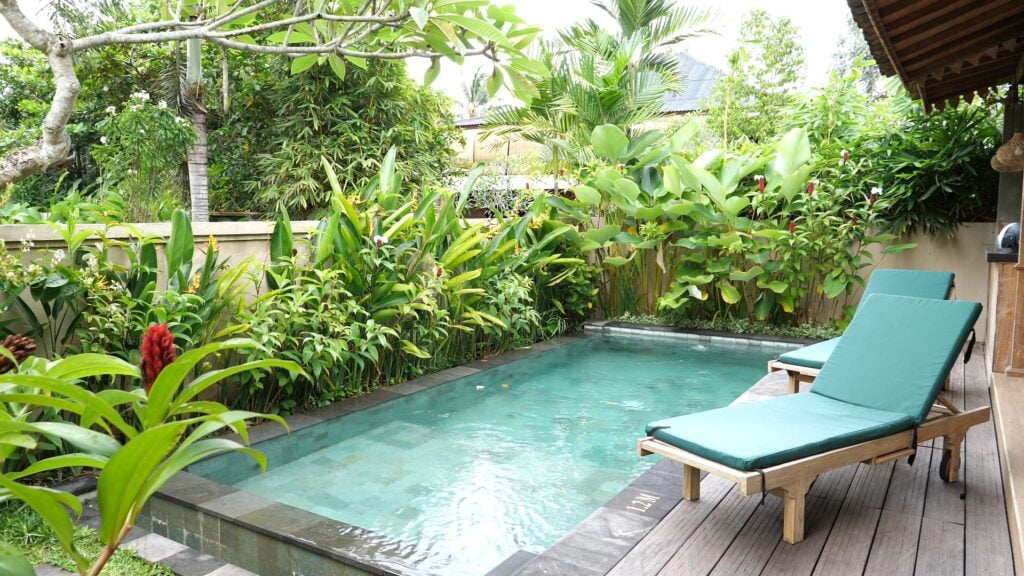
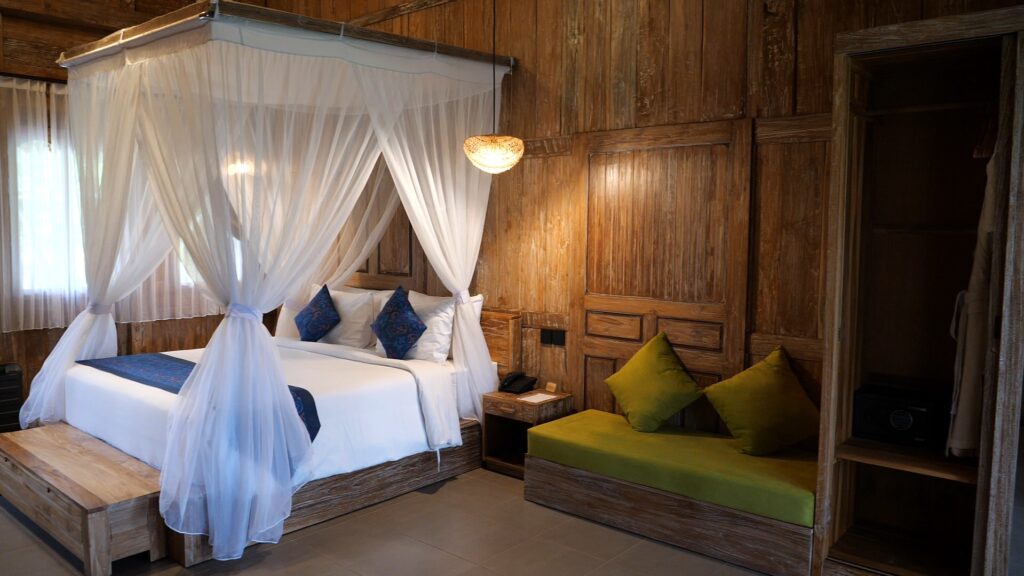
Top Restaurants in Ubud:
- Lemongrass Bisma Warung
- The Elephant Cafe
- Alchemy Cafe
- Zest Restaurant
- The Tropical Ants
- Good Day Resto & Pool Bar
- Made by Julia
- The Sayan House
- Wayan’s Warung
- The Upper Deck Restaurant
- Milk and Madu
Day 2: Ubud Center: Monkey Forest, Saraswati Temple, Campuhan Ridge Walk
Rise and shine! Your first day in Ubud will get you situated around Ubud Center.
After breakfast at your hotel or Good Day Resort & Pool Bar (bring a bikini), head right to Monkey Forest.
Hold onto your belongings! These monkeys love to borrow things without returning them.
If you go before noon, the monkeys will be out and about. They’ll likely be fed, and the sun won’t be beating down quite so much. Entrance costs no more than $7.
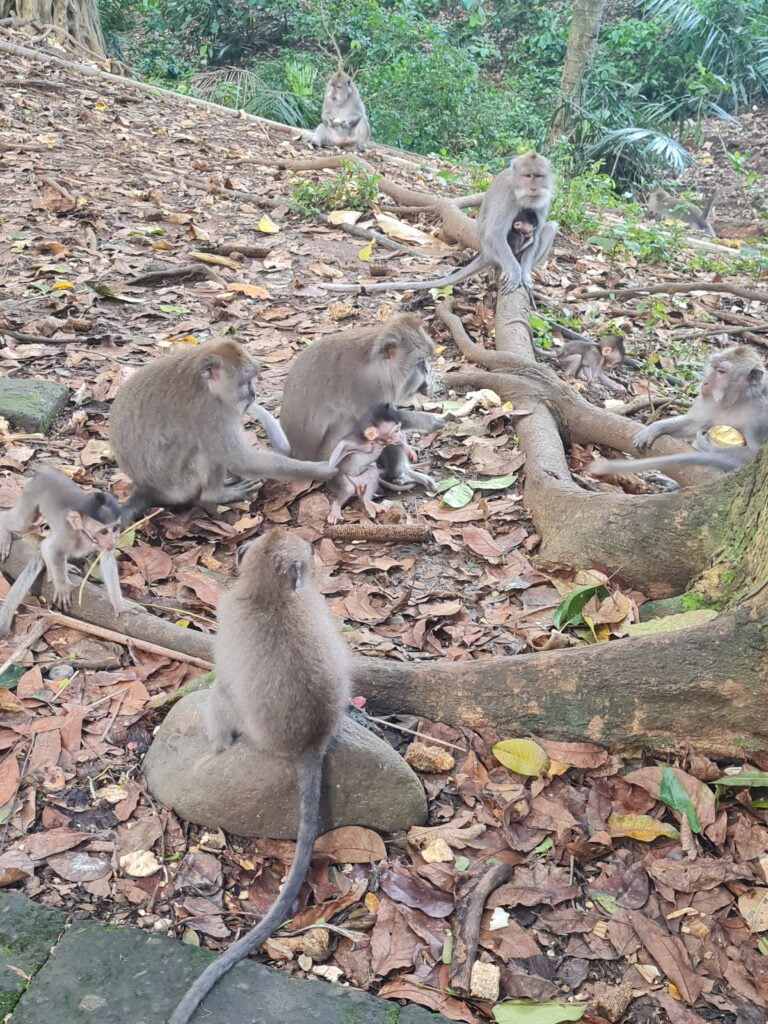
You’ll spend no more than 2 hours here. From there, take a 15 minute walk to explore cafes, street vendors and merchants, and cute shopping stores on-route to Saraswati Temple.
Of course, if you love shopping, this walk can easily turn into 2 hours.
At Saraswati Temple, cover up your knees and shoulders (or rent a Sarong), and enter this iconic temple. The architecture, positioning towards the sun, and history are one of a kind.
Saraswati, a Hindu Goddess, is known as the Goddess of Artistic and Intellectual Pursuit. She’s both a river and a goddess and is often depicted to ride on a Swan – a symbol of loyalty.
Her wisdom and guidance are known to come to you when you quiet your mind. If you’re keen, take a moment to sit in meditation inside the temple.
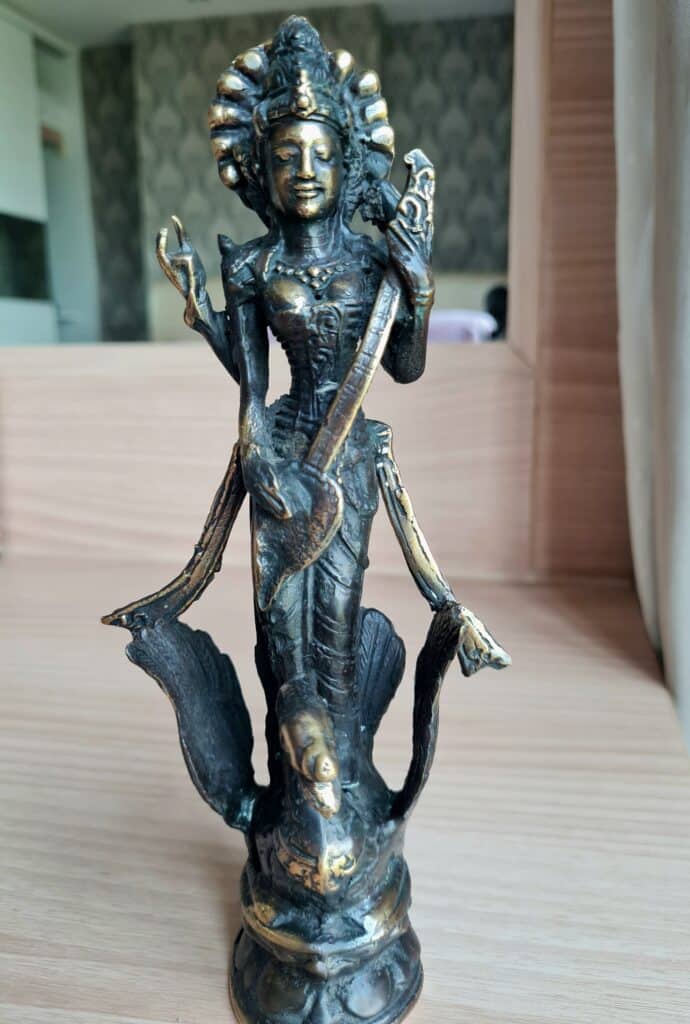
Day 2 – Afternoon
For lunch, you can either pick a restaurant around the temple or take a 20 minute walk just outside the Center to Elephant Cafe. They serve a mix of local and Western food and offer a one-of-a-kind view of the jungle.
From there, you’ll also see the trail of the Campuhan Ridge Walk, which I recommend you go on in the afternoon, after 2pm to avoid the midday sun. Grab a bunch of water.
After a 60 minute leisurely walk, you’ll arrive in a little village that boasts local cafes and restaurants as well as artists. All are situated amidst rice fields. It’s an iconic view and one of the closest tranquil spots near Ubud.
You can either walk back or get a taxi from the village for 100K Rupia to head back to Ubud Center.
For dinner, you may make reservations at Ubud Water Palace to sit down with a view over the palace and enjoy a performance of traditional Balinese dance while dining.
An alternative is the Sayan House from where you can overlook Ubud and the sun setting over the rice fields.
And early night is recommended, as you’ll need to get up quite early the next day.
Day 3: Ubud for the Soul – Mt. Batur, Waterfalls, Alchemy Yoga Center
One of my absolute highlights of any one week itinerary for Bali would have to be seeing a sunrise atop Mount Batur, one of the volcanoes of the island.
You’ll need to be up at 2am to catch your transfer to the foot of the mountain and begin your hike through the dark at 3:30am.
You’ll be guided by an experienced guide, and you’ll have breakfast served atop the mountain.
You can easily book your tour via GetYourGuide for about $30 per person. You can choose to add 2 hours at the Mount Batur Hot Springs after the climb, or not.
My vote? Sit in the hot springs.
Drinks, food, massages are all served right by the water. You’ll have stunning views across the lake towards Mount Agung.
Day 3 – Afternoon
Back in Ubud, it’s brunch/lunchtime! My favorite Warung in the Center is Lemongrass Warung, though you might also enjoy Zest for a more modern, vegan cuisine.
Back in Ubud, it’s time to decide which Waterfall to head to. Ubud is surrounded by water (remember Saraswati?)! Many waterfalls have a spring of ‘holy water’ nearby where you can sit in meditation and cleanse yourself.
Two of my absolute favorite waterfalls are:
Suwat Waterfall: A 40 minute drive will take you to this waterfall, where you’ll be led through a path on the left towards a natural pool, waterfall, and a fun opportunity to jump into the 7 meter deep pool. On the right, you can head towards a large Buddha statue where you can cleanse yourself with holy water. Locals there are some of the kindest I’ve met in Bali.
Waterfall Banking Djaran: A quiet and lush 30 minute drive will take you to this rather untouched waterfall. Take a dip in the natural pool, or sit on the side for a meditation. There’s a restaurant as well.

Having returned to Ubud, it’s time you head up to Alchemy Yoga and Meditation Center and get a class or two there.
Their afternoon classes are at 4pm and 6pm. After a while, the Center became the sole reason why I kept returning to Ubud.
Their classes are rooted in Kashmir Shaivism – a beautiful form of nonrenunciatory Hinduism. Their two yoga shalas are open to nature, made of Bamboo, and make for a tranquil, inviting atmosphere.
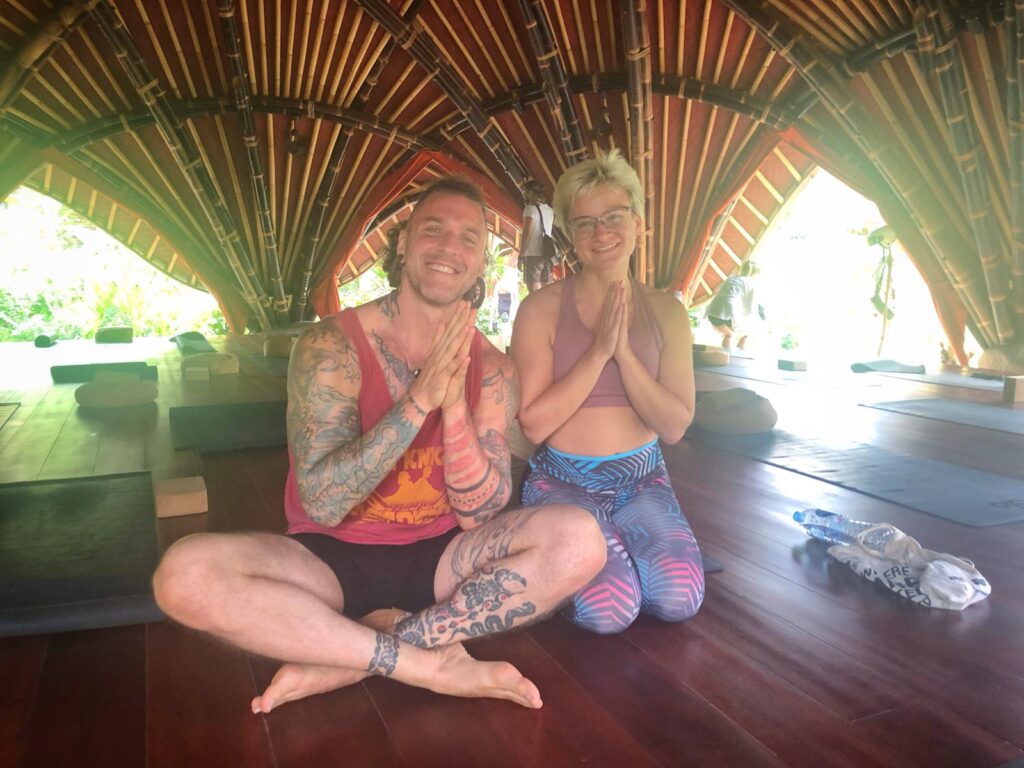
Day 4: Ulun Danu Beratan Temple – to Sanur – to Nusa Penida (or Lembongan (One night)
On day four, you’ll want to hire a private driver to take you to Ulun Dan Temple and to Sanur Harbor.
The Ulun Danu Temple consists of four distinct shrines, each of which are dedicated to a different God:
Danu, queen of water, lakes, and rivers; Shiva, the Destroyer; Vishnu, the Preserver of the balance of the Universe; and Brahma, the Creator.
Set in the Bedugul Regency on the site of Lake Baratan, many pilgrimage to the temple to pray for fertility, prosperity, and well-being.
Having spent a few hours there, it’s time to change sceneries entirely and, with that, islands.
Catch the 4pm ferry from Sanur Harbor across the waters to one of two islands: Penida or Lembongan.
Nusa Penida versus Nusa Lewmbongan
Penida is the more famous of the two, where you’ll find Kelingin Beach and the Broken Beach. Lembongan, I love and adore: Somewhat undiscovered by tourists, the island is reminiscent of what Bali must have been like 20 years ago.
You’ll find resorts, stunning beaches, great restaurants, and one-of-a-kind sunsets on either island. If you are truly up for adventure, go to Lembongan!
Ferries from Sanur: Have your driver take you to the correct booth (turn left, not right) to purchase your roundtrip tickets. You can take your belongings and it will be included in the fare.
Spend the evening watching the sunset at Devil’s Tears and have dinner overlooking the beach right there at Cafe Pandan (the burger is amazing!).
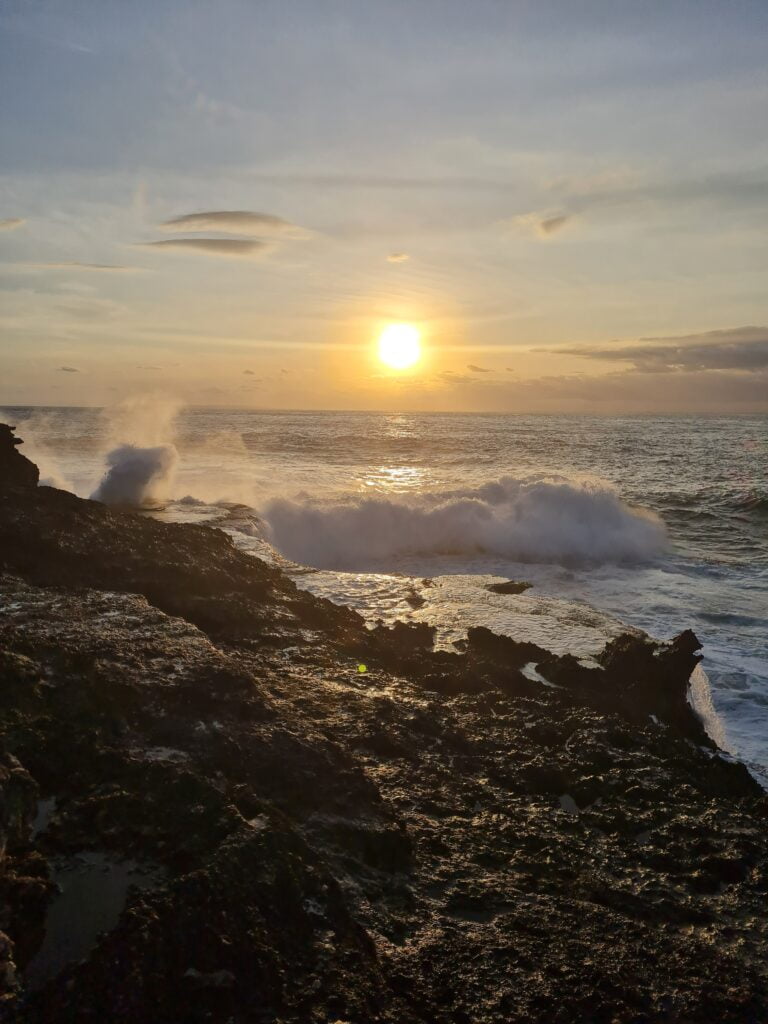
Where to stay in Penida:
- Backpackers’ Option: Melati Guesthouse
- Mid-range Option: Mambo Hill Resort
- Luxury Option: Eden Nature Villas with Private Pool
Where to stay in Lembongan:
- Backpackers’ Option: The Soggol Lembongan
- Mid-range Option: Tropical Garden by TANIS
- Luxury Option: Dream Beach Huts
Day 5: Nusa Lembongan + Transfer to Canguu (2-3 nights)
Rent a scooter from your hotel and explore the island! Here are three must-stops – and yes, they all fit in a 6 hour window.
Drive across what I call the Golden Gate Bridge of Lembongan and drive around the entire, tiny, neighboring island of Ceningan.
Once you’re off the bridge, turn left to begin your roundtrip which should take about 30 minutes. Pause at the Blue Lagoon for photos, a dip in the water, and a drink.
Once back on Lembongan, head North towards the Mangroves. Here, any friendly local will offer you a kayak tour through the Mangroves. An absolute YES, please!
Once back on your feet, it’s time for a quick adventure: Head to the Hidden Beach. The name won’t disappoint.
Time to head back to the hotel to grab your belongings. I highly recommend having a late lunch at the Mushroom beach which will be where you can get back on the ferry as well.
Take the 4pm ferry back to Sanur to beat the traffic in Bali. Get in the car with your driver for about 45 to 60 minutes, headed to your third and final hotel in Canggu!
Where to stay in Canggu:
- Backpacker’s option: Musa Canggu
- Mid-budget option: Paripadi Studio
- Luxury option: Theanna Villa and Spa
Where to eat in Canggu:
- Brunch Club Berawa (BEST pancakes in town)
- Pasta, BITTE (great…pasta)
- Moana Fish Eatery (great fish and cocktails)
- Warung Sunshine (local Warung close to beach)
- Pit Stop Burger (hole in the wall, best burger in town)
Seminyak versus Canggu
Many opt to stay in Seminyak over Canggu. Seminyak has recently become known for its hip and high-end resorts and hotels. It’s also right there by Kuta and Canggu which makes it easy to explore all three areas while there.
Personally, I find Canggu to be more charming as it has relatively fewer tourists, but more digital nomads (my people!), and more opportunities for shopping and lounging in cafes.
You can follow the same itinerary whether you opt to stay in Seminyak or Canggu.
Day 6: Day trip to Uluwatu Temple and Canggu Center
Now, I’ll say that Seminyak and Kuta offer fantastic beaches and surf lessons, if you’re done with temples. If beach is your preference over Uluwatu Temple, head to Kuta Beach, Double Six Beach, or Petitenget Beach.
If, however, you’re eager to explore one of the most scenic temples on the island, head to Uluwatu. I recommend leaving your hotel no later than 9am.
Uluwatu Temple is perched majestically atop the cliffs overlooking the Indian Ocean. The temple is a symbol of Bali’s cultural heritage and has a deep spiritual significance to locals.
The carvings and ancient sculptures inside tell the story of Bali’s past, customs, and traditions that continue to be passed down.
In order to make the most of your morning visit and learn in-depth about the history of the temple, you may wish to book a tour. Guides speak excellent English and are well-versed in the history of the site.
Upon returning to Canggu, it’s time to explore cafes, restaurants, and stores on Batu Bolong. If you start somewhere near Pasta, BITTE, you’ll get a gorgeous walk towards the beach.
Day 7: Morning visit to Tanah Lot + Canguu sunset
Get active in the morning before closing off your one week itinerary for Bali with a trip to Tanah Lot.
Canggu is packed with great opportunities for CrossFit, Spinning, or Yoga. I loved Zycle – right by the beach. You could grab a 7am spinning lesson there. It makes the pancakes at Brunch Club go down much more smoothly.
Once fed, it’s time to make one last stop at Tanah Lot. This temple was made famous by the myth that unmarried couples, upon entering the temple, will be cursed and fail to marry.
Well, Tanah Lot also happens to be the place where I fell in love with my partner, so there’s that. Then again, we didn’t go properly inside.
Tanah Lot is a special temple, sitting on top of a rock formation that is accessible only when the tide is out, revealing a slippery natural bridge from the mainland into the temple.
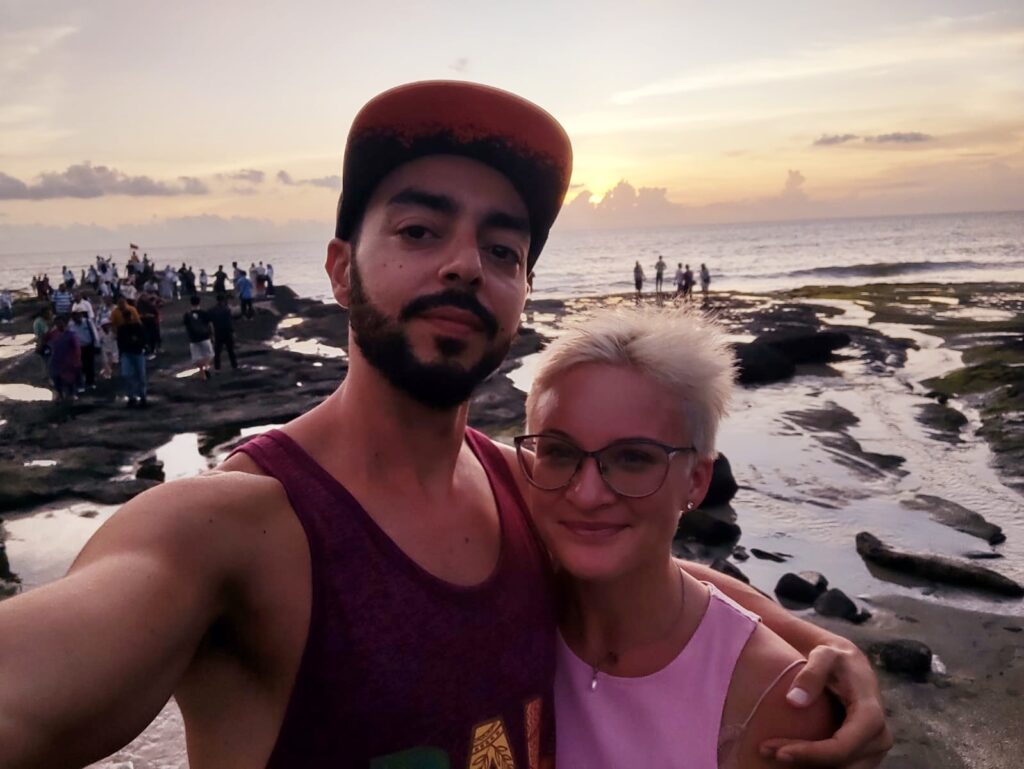
It is said that God Bather Segara, God of the Sea, invoked a poisonous snake to guard the rocky temple from intruders. Nowadays, you’ll find dedicated monks guarding the entrance to the temple and tending to its maintenance.
If you still have time before your flight, head to Pantai Batu Belig Beach, where you can have a farewell cocktail away from the crowds and with what will likely be a stunning sunset.
Transfer to Airport
Time to take your belongings and memories, pack them up, and head back to the airport. It can get crowded there. Make sure you get there two hours ahead of time. It’s fine to call a Grab, but easier and likely cheaper to have a private driver arranged ahead of time.
So long – will you be coming back to Bali?
Because there’s certainly more to explore.
Don’t forget:
- Book your travel insurance before you go.
- Book your private driver (DM me on Instagram)
- Download Grab
- Pre-book your tours to Mount Batur and the Uluwatu Temple
- Pack plenty of mosquito repellant
- Be prepared for Bali Belly and check reviews before dining.
Let me know what you love most about Mama Bali in the comments.
Pin, save, and share this article:







Great itinerary: the Zycle classes on the beach sound like a great way to start the day.
Yup! I totally loved it there. Make Sure you bring your own shoes though.
Those sunrise pictures look amazing!! I need to get to Bali!
It’s quite magical, for sure!
Beautiful photos! I would love to go to Bali
The picture don’t lie!
Ah! Bali is on my list and your post makes me want to go ASAP! You shared a wealth of information, thank you!
You’re so welcome! Holding for you to make it to Bali as soon as possible!
I have been to Bali around 30 years ago – it was one of my first solo trips in Asia and I loved it! Your pictures look fabulous and make me want to go back instantly.
Wow! I can’t imagine what Bali was like 30 years ago – likely way less polluted and less crowded.
Bali seems incredible! Love that you included so many tips in this post, there’s so much planning that goes into a big international trip and your post answers so many important questions. Amazingly detailed!
I hear you! When I first moved to Bali, I was doing research constantly. What’s great about Bali is that she does come with a uniquely inviting energy. Synchronicity is certainly an inevitable part of a journey to Bali, so don’t fret!
What a fabulous itinerary! I’m adding a kayak tour through mangroves to my list. I also appreciate all of your restaurant recommendations
Yay! You’re so welcome! <3
I absolutey love Bali and have visited several times and I think is a great one week itinerary for Bali!! You managed to visit all the top attractions as well as some hidden gems! Great post!
So glad to hear that!
Such a magical place that most people fall in love with and want to return. I need to go back again and try some things you suggested, like the yoga and visits to the temples. The Royal Ganesha accommodation looks lovely.
Yes, every visit to Bali is special and unique. Honestly, Alchemy Yoga has become such a sanctuary for me. It’s quite special.